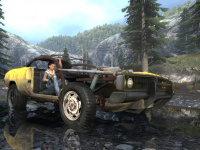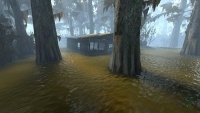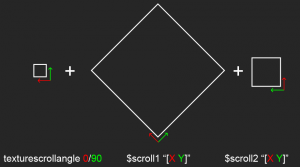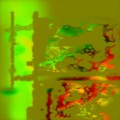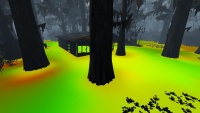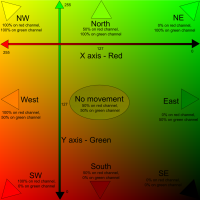Water
Water is a Pixel shader available in all ![]() Source games.
Source games.
It creates water that realistically reflects and refracts the world, and that can flow throughout a map.
Special behaviour
- Expensive and cheap
Watermaterials fall into two groups: expensive and cheap. Expensive water reflects and refracts the world in real-time, while cheap water uses an $envmap and does not refract. Users can disable expensive water rendering through their video options, so always place env_cubemap entities throughout a map.- Above and below
Wateractually requires two materials: one for above the surface and one for below. These materials are independent of each other, but for proper effect need to correlate in most areas.- Flow Mapping
- Water can flow in arbitrary directions. It's very tricky to create a flow map by hand however, and the tool Valve used internally hasn't been released.
Shader parameters
Textures
Need to set $abovewater for material x$reflecttexture, $abovewater and $envmap disabled, but can otherwise do whatever it wants. %notooltexture to the bottom material to hide it in the texture browser (not in effects\water_warp01. Requires $abovewater to be 0.$bumpmap), and a bump map for DirectX 9 and above ($normalmap). These should be animated unless the water is to be perfectly still or you're using a flow map, which makes an animated bump map redundant.
 Note:The
Note:The $normalmapparameter is unique to theWatershader, and uses a normal map. A du/dv map is used for $bumpmap when using theWatershader. The$dudvmapcommand is obsolete. Tip:Use
Tip:Use $bumptransformwith the TextureScroll proxy to move the normal map in pre-2006 engine branches.
$bumpframe affects $normalmap, which should be pointing to a bump map.- The default position is
center .5 .5 scale 1 1 rotate 0 translate 0 0.centerdefines the point of rotation. Only useful ifrotateis being used.scalefits the texture into the material the given number of times.2 1is a 50% scale in the horizontal X axis while the vertical Y axis is still at original scale.rotaterotates the texture counter-clockwise in degrees. Accepts any number, including negatives.translateshifts the texture by the given numbers..5will shift it half-way. 1 will shift it once completely over, which is the same as not moving it at all.
 Note:All values must be included!
Note:All values must be included! Bug:Scaling the texture may cause odd issues where the Texture Lock tool in Hammer will not actually lock the texture in place. [todo tested in ?]
Bug:Scaling the texture may cause odd issues where the Texture Lock tool in Hammer will not actually lock the texture in place. [todo tested in ?] Bug:Rotating textures applied on brushes will rotate around the map origin (confirm: Orangebox engine only?). A fix for this is to change the center position in the VMT to the brush's origin. [todo tested in ?]
Bug:Rotating textures applied on brushes will rotate around the map origin (confirm: Orangebox engine only?). A fix for this is to change the center position in the VMT to the brush's origin. [todo tested in ?]
In ![]() and
and ![]() 's Shadercode it will bundle up $Reflect/$RefractAmount into a single float4 to save some instructions, like so:
's Shadercode it will bundle up $Reflect/$RefractAmount into a single float4 to save some instructions, like so:
"[$ReflectAmount, $ReflectAmount, $RefractAmount, $RefractAmount]" This is pretty much $Scale but with two more components.
"The flashlight on the water surface is basically the diffuse flashlight * waterfogcolor * g_flFlashlightTint.
g_flFlashlightTint is tweakable in cases where the water fog color is really dark and the flashlight doesn't show up, etc."Fog
"[1 0 0]" and spew an error message saying Material x needs to have a $fogcolor.Cheap water treats this parameters as a linear value where 0.0 is 0% and 1.0 is 100%.
Expensive water treats this parameter as a Gamma value,
and due do this, each component ( red, green and blue respectively ) can not go above 1.0 or below 0.0 ( on expensive water )
x^(1/2.2) Warning:Must be 0 for edge fading to work properly.
Warning:Must be 0 for edge fading to work properly.
Reflection
This parameter is in Gamma space on expensive water, meaning it will be converted to linear before being sent to the shader.
x^(1/2.2) Note:Don't use this on underwater materials[Why?].
Note:Don't use this on underwater materials[Why?].
$envmap for reflections.$envmap. Refraction is assumed to be opaquely the water fog color.water_lod_control entity settings or the user's settings. Note:Requires a sky_camera entity to be placed in the map, otherwise this might cause crashes.
Note:Requires a sky_camera entity to be placed in the map, otherwise this might cause crashes.
 Bug:Does not do anything in any engine branch. [todo tested in ?]
Bug:Does not do anything in any engine branch. [todo tested in ?]
Refraction
 Tip:Specify
Tip:Specify $refracttexturewithout$reflecttextureto get real-time refraction on$envmapreflections.
To calculate the eventual linear value that the shader is supplied with, apply the formula
x^(1/2.2) Warning:Underwater materials only; this will cause buggy behavior on any material with
Warning:Underwater materials only; this will cause buggy behavior on any material with $abovewaterset to 1.
$pseudotranslucent is enabled. At 0, the water is completely transparent, while at 1 the water is completely opaque.Flowing water
$scroll1 "[<normal X> <normal Y>]"(in all games since )
)$scroll2 "[<normal X> <normal Y>]"(in all games since )
)- If
$scroll1is defined and X is not zero, two more instances of the normal map will be drawn in such a way that they are merged together. The first layer is 7x larger and rotated 45°; the second is 2x larger and rotated 90°. The parameters specify the speed and direction that the extra layers will move. (Valve's materials usually contain a third number, but it doesn't have any apparent effect and is most likely obsolete.)
Flow maps
$normalmap. Valve generates their flowmaps with Houdini.
- Video of the effect. For technical details, see Alex Vlachos' SIGGRAPH 2010 paper and Valve's GDC 2011 paper.
$flow_uvscrolldistance.Basetexture Flow
$color_flow_uvscrolldistance.- Todo: Better explanation
Authoring a flow map
Overall, trying to create a flow map manually is a nightmare. Painting the flow map, fitting it into the world, and painting foam, is extremely difficult.
But if you do want to give it a try, flow direction is read from the red and green channels of the flow map. 50% tone means no movement.
The texture scale of any faces using a water texture with a flow map appear to have a direct correlation on the flow map. The fewer water faces or planes you use the easier the process of authoring a custom flow map will be (selecting all of your water faces and using 'treat as one' when using the fit scaling may also be an option)
- There are now tools to assist in painting flowmaps.
- Flow field editor from algoholic.eu : http://algoholic.eu/another-flow-field-editor-update/ [dead link]
- Flowmap generator (paid): http://www.superpositiongames.com/products/flowmap-generator
- Creating flowmaps using Houdini (UDK) : https://www.dropbox.com/s/ii2x077vj64lyhl/Water%20Flow%20For%20UDK.pdf [dead link]
Other
WaterLOD proxy- This connects the water_lod_control entity in a level to the water’s internal parameters. This must be declared in the material for the LOD mechanisms to work properly.
